 ★★★★
★★★★
“Let’s Get Ready to Rumble…”

 This is our first ever video game review on gwg.org, and just so you know I’m not making any of this up, here’s a synopsis of the storyline for this one, taken from IGN.com: “A sick and twisted half-naked scientist has decided to dress up like a nurse and hold an international wrestling tournament for the world’s greatest female grapplers. Once the women have entered, the evil doctor then takes samples of their DNA so that she can create a cyborg super-soldier to do her bidding for some unknown purpose. In the meantime, the mad puppeteer has also decided to brainwash all the contestants she’s met by turning them into an army of trashy, leglock-giving bad girls with skirts so short they should be called Smurfs.”
This is our first ever video game review on gwg.org, and just so you know I’m not making any of this up, here’s a synopsis of the storyline for this one, taken from IGN.com: “A sick and twisted half-naked scientist has decided to dress up like a nurse and hold an international wrestling tournament for the world’s greatest female grapplers. Once the women have entered, the evil doctor then takes samples of their DNA so that she can create a cyborg super-soldier to do her bidding for some unknown purpose. In the meantime, the mad puppeteer has also decided to brainwash all the contestants she’s met by turning them into an army of trashy, leglock-giving bad girls with skirts so short they should be called Smurfs.”
On the off-chance that you are not already whizzing out the door to your nearest electronics store to obtain this title, I’ll tell you more, but first a little background. I’m not a great computer game player, having completed precisely three in my life (Zork, Doom and Tomb Raider), but Chris bought me this for Christmas [how I love my wife!], so naturally I felt morally obliged to play it… The basic concept is straight out of Game Cliche Academy; a bunch of characters with various motives, get together to beat the crap out of each other in a range of interesting ways. See also Street Fighter II, Mortal Kombat, Dead or Alive, etc. etc. The key difference here that while most offer a token woman or two, here, every character is female, which may be a unique feature for a Western release [there was an AJW game for the Playstation, but it was Japan only]
 It’s kinda hard to decide whether this is feminist or sexist. There’s no doubt that these are strong, independent women who can kick ass with the best of them. Yet they also wear outfits which would prove structurally unfeasible in real life, and you could say the same thing about physical attributes resembling a multiple Zeppelin pile-up. Then there’s “mud mode” (left), which is exactly what it sounds like. Of course, this cheesecake aspect is far from unheard of: Dead or Alive: Beach Volleyball took the female characters from the beat-em-up game and put them in swimsuits to play volleyball against each other. Yet, its roleplaying aspects made that one a favourite with our teenage daughter as much as our son. That’s unlikely here, shall we say.
It’s kinda hard to decide whether this is feminist or sexist. There’s no doubt that these are strong, independent women who can kick ass with the best of them. Yet they also wear outfits which would prove structurally unfeasible in real life, and you could say the same thing about physical attributes resembling a multiple Zeppelin pile-up. Then there’s “mud mode” (left), which is exactly what it sounds like. Of course, this cheesecake aspect is far from unheard of: Dead or Alive: Beach Volleyball took the female characters from the beat-em-up game and put them in swimsuits to play volleyball against each other. Yet, its roleplaying aspects made that one a favourite with our teenage daughter as much as our son. That’s unlikely here, shall we say.
On the other hand, the in-ring battles are still a step or two more credible than anything I’ve seen out of a regular all-woman federation in the US [I did enjoy the Heatwave show staged by IZW here in Phoenix, which was a one-off event], and approximately ten miles ahead of the farce that passes for woman’s wrestling in the WWE these days. Admittedly, in terms of personality, they’re from the shallow end of the character pool – teacher, nurse, punk rock chick, etc – but again, this compares not unfavourably with the sole flavour, Silicone Slut, available in the WWE.
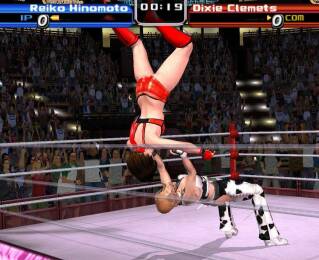 My playing-style is your average button-masher, but it took me only an hour or so to beat the game with my first character – there are ten to choose from at the beginning, and playing through story mode in each one unlocks their alter-ego. Play through all 20, and you can be the bosses too, but be warned: the voice acting is horrible, and the storylines positively wince-inducing. In addition, you can play straightforward exhibition matches, and carrying out certain tasks, known as “vows” e.g. winning inside three minutes, can cause characters to switch from good to bad versions too. A problem here seems to be that you can’t have both alignments active simultaneously, so you’re not able to have Reiko Hinomoto (nice) take on Rowdy Reiko (naughty).
My playing-style is your average button-masher, but it took me only an hour or so to beat the game with my first character – there are ten to choose from at the beginning, and playing through story mode in each one unlocks their alter-ego. Play through all 20, and you can be the bosses too, but be warned: the voice acting is horrible, and the storylines positively wince-inducing. In addition, you can play straightforward exhibition matches, and carrying out certain tasks, known as “vows” e.g. winning inside three minutes, can cause characters to switch from good to bad versions too. A problem here seems to be that you can’t have both alignments active simultaneously, so you’re not able to have Reiko Hinomoto (nice) take on Rowdy Reiko (naughty).
The controls are similar for all the characters, but they have different move sets, so that adds variety. Personally, I sorely wanted a practice mode (like Dead or Alive, for example); as is, the only way to learn is in actual matches, hardly the best way. I remain clueless about blocking attacks, but muddled through, despite some annoying occasions where my AI opponent seemed to perform a lengthy string of attacks that I could do nothing to counter. On offense, successful moves gradually fill up your meter (the yellow bar at the top); each completion gives you the chance to perform a lethal attack. Computer-controlled fighters tend not to use it immediately; don’t make that mistake, as a lethality, followed up if necessary by a pin attempt, is a good way to win.
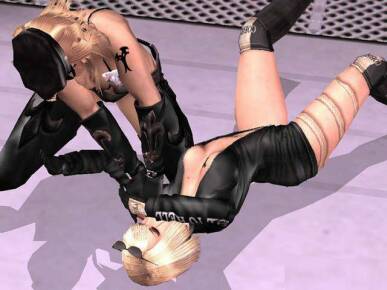 The graphics kick ass. An awful lot of polygons (I believe around 10,000!) go into each character, with detailed hair, costumes, tattoos, backgrounds and other refinements that look good even on the biggest TV set. However, when the wrestlers run, it sometimes doesn’t work at all. The music is pretty lame J-Pop, so you’ll probably rapidly find yourself turning off the entrance videos too. On the down side, as well as practice mode, we could have used tag matches, survival mode, create-a-character, a bigger range of locations… The options present here are pretty sparse, though in gaming I suppose it’s usually better not to be a jack-of-all-trades.
The graphics kick ass. An awful lot of polygons (I believe around 10,000!) go into each character, with detailed hair, costumes, tattoos, backgrounds and other refinements that look good even on the biggest TV set. However, when the wrestlers run, it sometimes doesn’t work at all. The music is pretty lame J-Pop, so you’ll probably rapidly find yourself turning off the entrance videos too. On the down side, as well as practice mode, we could have used tag matches, survival mode, create-a-character, a bigger range of locations… The options present here are pretty sparse, though in gaming I suppose it’s usually better not to be a jack-of-all-trades.
Still, with all the different characters, there would certainly be plenty to keep the dedicated completist playing. I’m not sure I’ll have quite the stamina to do that, and it’s more likely to be the kind of thing I pick up casually for half an hour. It is definitely a guys’ game – our aforementioned teenage daughter used the word “nasty” more than once while spectating – and contains enough elements to have Chris’s eyes rolling, such as the mud and gallery mode. But as a crass, shallow, mildly guilty pleasure, it’s great, and despite some obvious short-comings with the story and lack of variety, as a wrestling game, it’s actually pretty good. Now, if you’ll pardon me, I must go ice down my thumbs.
Dist: Konami
Platform: Playstation 2
 After the excesses of Lady Terminator, I hoped for something equally as berserk here: instead, however, I got a reminder of why I sometimes hate Troma so much. Here, they took a fairly lame Indonesian movie (called, I believe, The Stabilizer) and handed it to the brother of head honcho Lloyd Kaufmann, who wrote a “funny” script and dubbed it: imagine What’s Up Tiger Lily with fart gags replacing all wit and humour. Here’s a sample: they make the hero an Elvis impersonator. Oh, hold my sides, for I fear they may split with laughter…not.
After the excesses of Lady Terminator, I hoped for something equally as berserk here: instead, however, I got a reminder of why I sometimes hate Troma so much. Here, they took a fairly lame Indonesian movie (called, I believe, The Stabilizer) and handed it to the brother of head honcho Lloyd Kaufmann, who wrote a “funny” script and dubbed it: imagine What’s Up Tiger Lily with fart gags replacing all wit and humour. Here’s a sample: they make the hero an Elvis impersonator. Oh, hold my sides, for I fear they may split with laughter…not.




 ★★★★
★★★★
 This is our first ever video game review on gwg.org, and just so you know I’m not making any of this up, here’s a synopsis of the storyline for this one, taken from
This is our first ever video game review on gwg.org, and just so you know I’m not making any of this up, here’s a synopsis of the storyline for this one, taken from  It’s kinda hard to decide whether this is feminist or sexist. There’s no doubt that these are strong, independent women who can kick ass with the best of them. Yet they also wear outfits which would prove structurally unfeasible in real life, and you could say the same thing about physical attributes resembling a multiple Zeppelin pile-up. Then there’s “mud mode” (left), which is exactly what it sounds like. Of course, this cheesecake aspect is far from unheard of: Dead or Alive: Beach Volleyball took the female characters from the beat-em-up game and put them in swimsuits to play volleyball against each other. Yet, its roleplaying aspects made that one a favourite with our teenage
It’s kinda hard to decide whether this is feminist or sexist. There’s no doubt that these are strong, independent women who can kick ass with the best of them. Yet they also wear outfits which would prove structurally unfeasible in real life, and you could say the same thing about physical attributes resembling a multiple Zeppelin pile-up. Then there’s “mud mode” (left), which is exactly what it sounds like. Of course, this cheesecake aspect is far from unheard of: Dead or Alive: Beach Volleyball took the female characters from the beat-em-up game and put them in swimsuits to play volleyball against each other. Yet, its roleplaying aspects made that one a favourite with our teenage  My playing-style is your average button-masher, but it took me only an hour or so to beat the game with my first character – there are ten to choose from at the beginning, and playing through story mode in each one unlocks their alter-ego. Play through all 20, and you can be the bosses too, but be warned: the voice acting is horrible, and the storylines positively wince-inducing. In addition, you can play straightforward exhibition matches, and carrying out certain tasks, known as “vows” e.g. winning inside three minutes, can cause characters to switch from good to bad versions too. A problem here seems to be that you can’t have both alignments active simultaneously, so you’re not able to have Reiko Hinomoto (nice) take on Rowdy Reiko (naughty).
My playing-style is your average button-masher, but it took me only an hour or so to beat the game with my first character – there are ten to choose from at the beginning, and playing through story mode in each one unlocks their alter-ego. Play through all 20, and you can be the bosses too, but be warned: the voice acting is horrible, and the storylines positively wince-inducing. In addition, you can play straightforward exhibition matches, and carrying out certain tasks, known as “vows” e.g. winning inside three minutes, can cause characters to switch from good to bad versions too. A problem here seems to be that you can’t have both alignments active simultaneously, so you’re not able to have Reiko Hinomoto (nice) take on Rowdy Reiko (naughty). The graphics kick ass. An awful lot of polygons (I believe around 10,000!) go into each character, with detailed hair, costumes, tattoos, backgrounds and other refinements that look good even on the biggest TV set. However, when the wrestlers run, it sometimes doesn’t work at all. The music is pretty lame J-Pop, so you’ll probably rapidly find yourself turning off the entrance videos too. On the down side, as well as practice mode, we could have used tag matches, survival mode, create-a-character, a bigger range of locations… The options present here are pretty sparse, though in gaming I suppose it’s usually better not to be a jack-of-all-trades.
The graphics kick ass. An awful lot of polygons (I believe around 10,000!) go into each character, with detailed hair, costumes, tattoos, backgrounds and other refinements that look good even on the biggest TV set. However, when the wrestlers run, it sometimes doesn’t work at all. The music is pretty lame J-Pop, so you’ll probably rapidly find yourself turning off the entrance videos too. On the down side, as well as practice mode, we could have used tag matches, survival mode, create-a-character, a bigger range of locations… The options present here are pretty sparse, though in gaming I suppose it’s usually better not to be a jack-of-all-trades.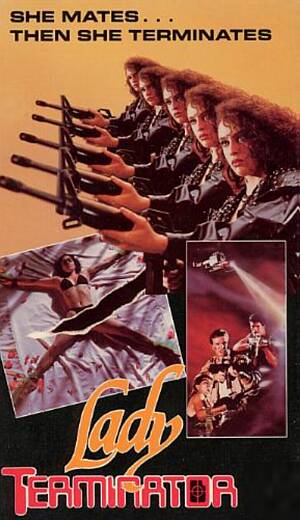 Watching the unstoppable female killing machine in this 1988 Indonesian film might make Terminator 3 seem less original – except most of the concept here, as well as entire scenes and exact lines of dialogue, come directly from the
Watching the unstoppable female killing machine in this 1988 Indonesian film might make Terminator 3 seem less original – except most of the concept here, as well as entire scenes and exact lines of dialogue, come directly from the  True story. A friend of ours has a job as an intern in Los Angeles, and coming round the corner at work one day, he literally bumped into Jennifer Garner. He immediately started apologising profusely (he’s an uber-nice kid, who wouldn’t say “Boo!” to a fly) but she wouldn’t have any of it and began cursing him out in the nastiest of ways. Garner finally stalked off, while he continued to apologise – just before vanishing, she turned round and gave him the finger. So now we know: Jennifer Garner = bitch.
True story. A friend of ours has a job as an intern in Los Angeles, and coming round the corner at work one day, he literally bumped into Jennifer Garner. He immediately started apologising profusely (he’s an uber-nice kid, who wouldn’t say “Boo!” to a fly) but she wouldn’t have any of it and began cursing him out in the nastiest of ways. Garner finally stalked off, while he continued to apologise – just before vanishing, she turned round and gave him the finger. So now we know: Jennifer Garner = bitch.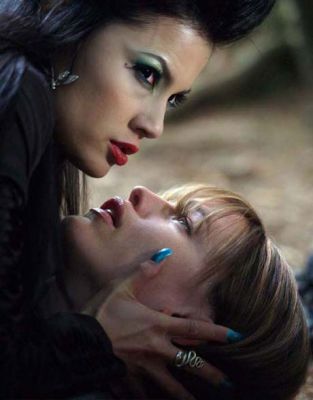 There is entertainment, mostly lurking in the background. A moment with impact sees Typhoid (Natassia Malthe), the girl with the poison touch, kiss Elektra; the pair fall to the ground surrounded by a shower of dying leaves. It feels almost like it could have been inspired by the work of Zhang Yimou (House of Flying Daggers), and is at least less obviously stolen than the “House of Flying Bed-Sheets” battle later on. It’s also interesting to see Mark Houghton as a chief bodyguard in the opening scene: he made his debut against Yukari Oshima in The Outlaw Brothers, back in 1987.
There is entertainment, mostly lurking in the background. A moment with impact sees Typhoid (Natassia Malthe), the girl with the poison touch, kiss Elektra; the pair fall to the ground surrounded by a shower of dying leaves. It feels almost like it could have been inspired by the work of Zhang Yimou (House of Flying Daggers), and is at least less obviously stolen than the “House of Flying Bed-Sheets” battle later on. It’s also interesting to see Mark Houghton as a chief bodyguard in the opening scene: he made his debut against Yukari Oshima in The Outlaw Brothers, back in 1987.

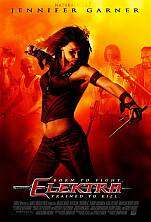

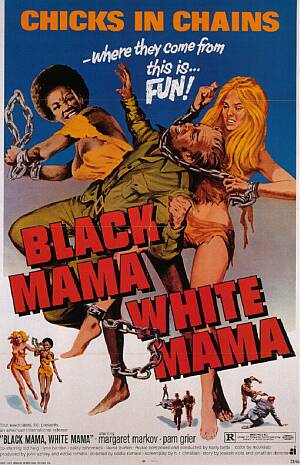 The biggest shock this has to offer is likely the opening credit, “based on an original story by Joseph Viola and…
The biggest shock this has to offer is likely the opening credit, “based on an original story by Joseph Viola and… In my collection, I have DVDs from six different American wrestling federations, plus others from Japan. This is, by far, the most tedious and badly-put together. There isn’t an aspect here that even reaches bearable: the wrestlers are almost without exception incompetent, the announcers are juvenile jerks, and the presentation is truly dreadful. Shot at WEW’s first two pay-per-views at Viking Hall, Philadelphia on February 22nd and April 6th, 2002, it is frankly a mystery how the company didn’t immediately fold. But rising from the remnants of GLOOW, it uses some of the same “talent” plus porn stars, and still seems to be offering its X-rated mix of sex and violence – though this DVD entirely lacks the nudity promised by the commentators, which has presumably been edited out. Really, all the naked female flesh in North America wouldn’t have helped this – the only thing that’s “extreme” is some bad language, and while I could be wrong, personally, there’s more to being extreme than a potty-mouth.
In my collection, I have DVDs from six different American wrestling federations, plus others from Japan. This is, by far, the most tedious and badly-put together. There isn’t an aspect here that even reaches bearable: the wrestlers are almost without exception incompetent, the announcers are juvenile jerks, and the presentation is truly dreadful. Shot at WEW’s first two pay-per-views at Viking Hall, Philadelphia on February 22nd and April 6th, 2002, it is frankly a mystery how the company didn’t immediately fold. But rising from the remnants of GLOOW, it uses some of the same “talent” plus porn stars, and still seems to be offering its X-rated mix of sex and violence – though this DVD entirely lacks the nudity promised by the commentators, which has presumably been edited out. Really, all the naked female flesh in North America wouldn’t have helped this – the only thing that’s “extreme” is some bad language, and while I could be wrong, personally, there’s more to being extreme than a potty-mouth.
 Combining elements from Dead Like Me and Ghost, this still manages to come up with something unique, especially given its origins as a prequel to a popular TV series. It is designed to explain how Mina (Shaku) got the job as Keeper of the Gate, where murder victims must decide whether to forgo revenge and pass on, return to Earth as a ghost, or seek vengeance at the price of eternal torment. She ends up there after having her heart torn out on her wedding day by insane billionaire serial killer Kudo (Osawa) who will stop at nothing to save his one true love, currently lying in a coma. Trust me – it all makes perfect sense, and it’s a particularly nice touch that Mina’s fiance, Detective Kohei (Shosuke) is equally driven in his actions by love.
Combining elements from Dead Like Me and Ghost, this still manages to come up with something unique, especially given its origins as a prequel to a popular TV series. It is designed to explain how Mina (Shaku) got the job as Keeper of the Gate, where murder victims must decide whether to forgo revenge and pass on, return to Earth as a ghost, or seek vengeance at the price of eternal torment. She ends up there after having her heart torn out on her wedding day by insane billionaire serial killer Kudo (Osawa) who will stop at nothing to save his one true love, currently lying in a coma. Trust me – it all makes perfect sense, and it’s a particularly nice touch that Mina’s fiance, Detective Kohei (Shosuke) is equally driven in his actions by love. Director Ichimura returned for the fourth episode, and despite similar problems as the third installment – most obviously, an apparent doubt that Oichi’s character can hold the viewer’s interest by herself – makes a much better stab at things here. Bounty-hunter Oichi finds out what life is like on the other side of the law, after she helps rescue an unwilling bride from a local magistrate; he slaps a 100 gold-piece reward on her head, which naturally, brings other bounty-hunters on her trail, led by Sankuro (Meguro).
Director Ichimura returned for the fourth episode, and despite similar problems as the third installment – most obviously, an apparent doubt that Oichi’s character can hold the viewer’s interest by herself – makes a much better stab at things here. Bounty-hunter Oichi finds out what life is like on the other side of the law, after she helps rescue an unwilling bride from a local magistrate; he slaps a 100 gold-piece reward on her head, which naturally, brings other bounty-hunters on her trail, led by Sankuro (Meguro). The third entry in the series saw a new director, and unfortunately, a marked turn for the worse, largely because the focus drifts off Oichi. It starts briskly enough, with the heroine coming into possession of a new, effective formula for gunpowder, something barely known at the time in Japan. Understandably, this makes her the focus of attention, in particular for a group with an interest in profiting from the discovery.
The third entry in the series saw a new director, and unfortunately, a marked turn for the worse, largely because the focus drifts off Oichi. It starts briskly enough, with the heroine coming into possession of a new, effective formula for gunpowder, something barely known at the time in Japan. Understandably, this makes her the focus of attention, in particular for a group with an interest in profiting from the discovery.